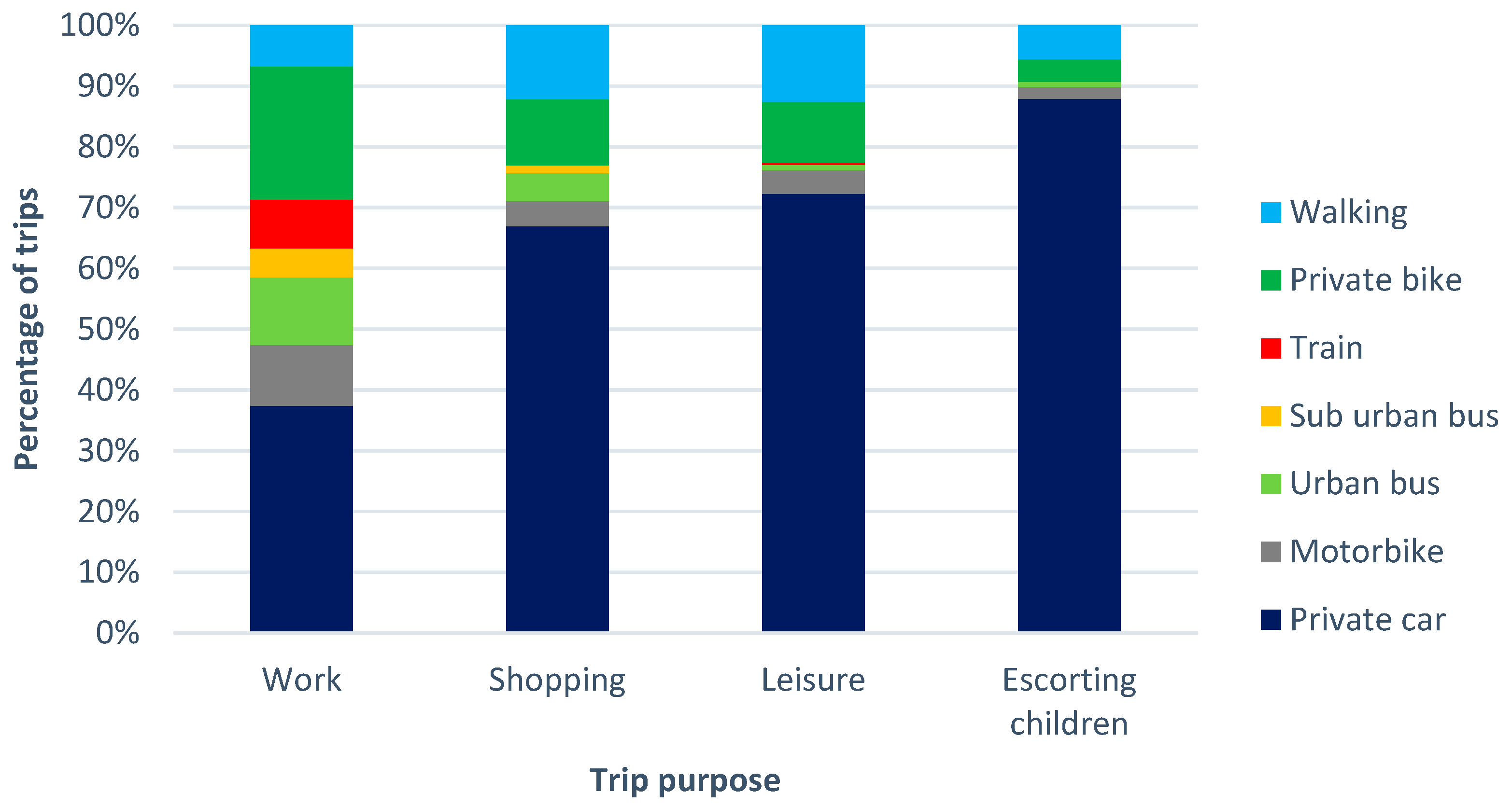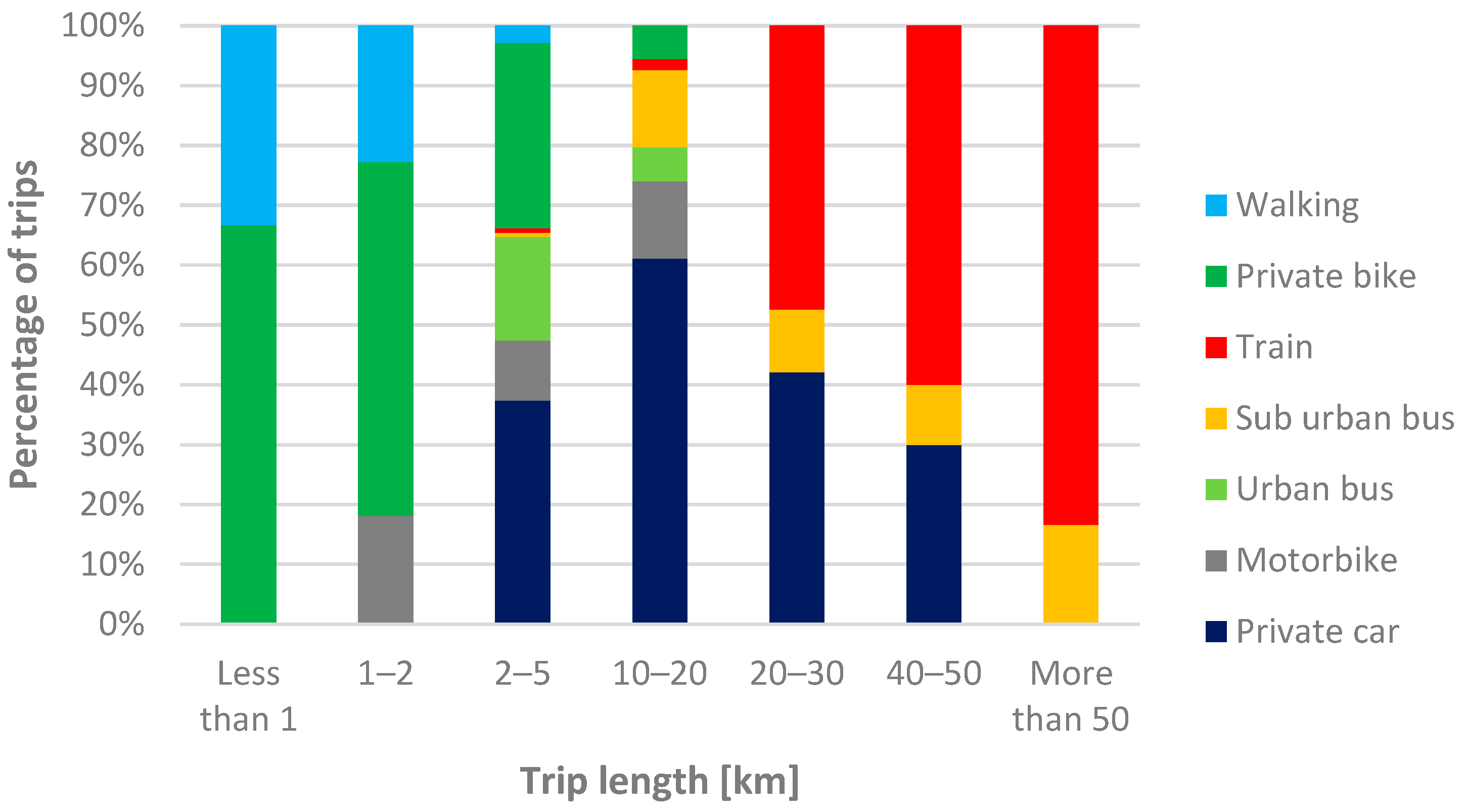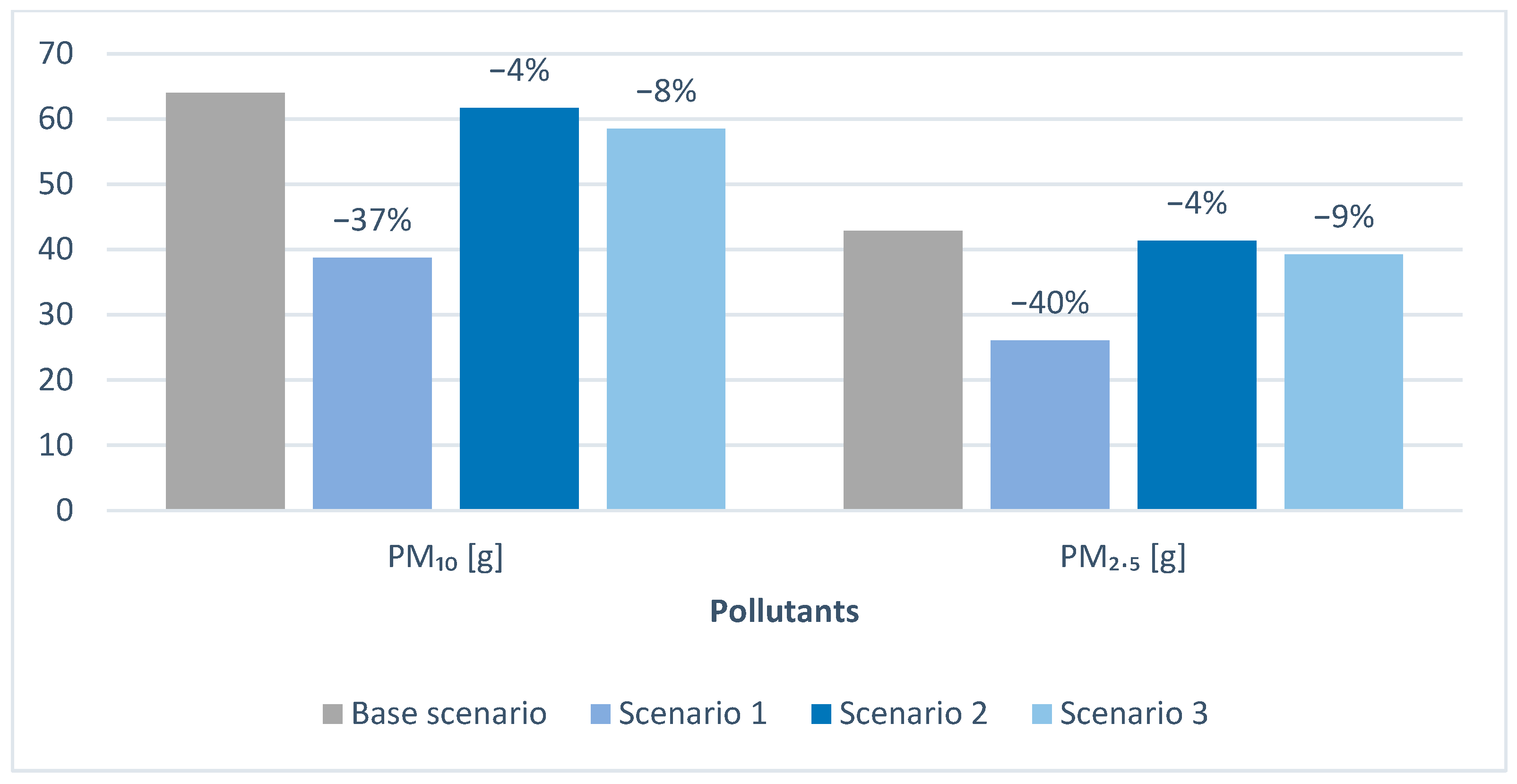MaaS Adoption and Sustainability for Systematic Trips: Estimation of Environmental Impacts in a Medium-Sized City
Abstract
1. Introduction
2. Materials and Methods
2.1. Data Collection
2.2. Model for MaaS Adoption Forecasting
2.3. Emission Estimates
3. Results
3.1. Descriptive Statistics of the Sample
3.2. Model Estimation
3.3. MaaS Adoption Scenarios
- Scenario 1, in which the probability of MaaS adoption is maximized;
- Scenario 2, in which the probability of MaaS adoption is minimized;
- Scenario 3, which includes mobility services currently managed by the same operator in the city, thus representing the most feasible MaaS that could be implemented in the area.
4. Discussion
5. Conclusions
- The opportunity to have multimodal mobility options that can provide door-to-door trips is a fundamental element to ensure a wide diffusion of MaaS;
- Public transport is confirmed to be the backbone of such a system; therefore, efforts to guarantee a high level of service of public transit could be key elements to promote MaaS adoption;
- The risk of shifting to less sustainable travel modes included in the bundle could not occur in the study area, since frequent bikers and those who commuted by train or walking are not willing to join the service.
Author Contributions
Funding
Institutional Review Board Statement
Informed Consent Statement
Data Availability Statement
Acknowledgments
Conflicts of Interest
References
- Caiati, V.; Rasouli, S.; Timmermans, H. Bundling, Pricing Schemes and Extra Features Preferences for Mobility as a Service: Sequential Portfolio Choice Experiment. Transp. Res. Part A Policy Pract. 2020, 131, 123–148. [Google Scholar] [CrossRef]
- Wu, J.; Qu, X. Intersection Control with Connected and Automated Vehicles: A Review. J. Intell. Connect. Veh. 2022, 5, 260–269. [Google Scholar] [CrossRef]
- Xu, L.; Jin, S.; Li, B.; Wu, J. Traffic Signal Coordination Control for Arterials with Dedicated CAV Lanes. J. Intell. Connect. Veh. 2023, 5, 72–87. [Google Scholar] [CrossRef]
- Alyavina, E.; Nikitas, A.; Njoya, E.T. Mobility as a Service (MaaS): A Thematic Map of Challenges and Opportunities. Res. Transp. Bus. Manag. 2022, 43, 100783. [Google Scholar] [CrossRef]
- Enoch, M.; Potter, S. MaaS (Mobility as a Service) Market Futures Explored. Transp. Policy 2023, 134, 31–40. [Google Scholar] [CrossRef]
- Labee, P.; Rasouli, S.; Liao, F. The Implications of Mobility as a Service for Urban Emissions. Transp. Res. Part D Transp. Environ. 2022, 102, 103128. [Google Scholar] [CrossRef]
- Hensher, D.A.; Mulley, C.; Nelson, J.D. Mobility as a Service (MaaS)—Going Somewhere or Nowhere? Transp. Policy 2021, 111, 153–156. [Google Scholar] [CrossRef]
- Ho, C.Q.; Mulley, C.; Hensher, D.A. Public Preferences for Mobility as a Service: Insights from Stated Preference Surveys. Transp. Res. Part A Policy Pract. 2020, 131, 70–90. [Google Scholar] [CrossRef]
- Kriswardhana, W.; Eszterg’ar-Kiss, D. Exploring the Aspects of MaaS Adoption Based on College Students’ Preferences. Transp. Policy 2023, 136, 113–125. [Google Scholar] [CrossRef]
- Matyas, M. Opportunities and Barriers to Multimodal Cities: Lessons Learned from in-Depth Interviews about Attitudes towards Mobility as a Service. Eur. Transp. Res. Rev. 2020, 12, 7. [Google Scholar] [CrossRef]
- Alyavina, E.; Nikitas, A.; Tchouamou Njoya, E. Mobility as a Service and Sustainable Travel Behaviour: A Thematic Analysis Study. Transp. Res. Part F Traffic Psychol. Behav. 2020, 73, 362–381. [Google Scholar] [CrossRef]
- Hensher, D.A.; Ho, C.Q.; Reck, D.J. Mobility as a Service and Private Car Use: Evidence from the Sydney MaaS Trial. Transp. Res. Part A Policy Pract. 2021, 145, 17–33. [Google Scholar] [CrossRef]
- Butler, L.; Yigitcanlar, T.; Paz, A. Barriers and Risks of Mobility-as-a-Service (MaaS) Adoption in Cities: A Systematic Review of the Literature. Cities 2021, 109, 103036. [Google Scholar] [CrossRef]
- Hensher, D.A.; Mulley, C.; Nelson, J.D. What Is an Ideal (Utopian) Mobility as a Service (MaaS) Framework? A Communication Note. Transp. Res. Part A Policy Pract. 2023, 172, 103675. [Google Scholar] [CrossRef]
- Hensher, D.A. The Reason MaaS Is Such a Challenge: A Note. Transp. Policy 2022, 129, 137–139. [Google Scholar] [CrossRef]
- Hensher, D.A.; Nelson, J.D.; Mulley, C. Electric Car Sharing as a Service (ECSaaS)—Acknowledging the Role of the Car in the Public Mobility Ecosystem and What It Might Mean for MaaS as EMaaS? Transp. Policy 2022, 116, 212–216. [Google Scholar] [CrossRef]
- Hensher, D.A.; Hietanen, S. Mobility as a Feature (MaaF): Rethinking the Focus of the Second Generation of Mobility as a Service (MaaS). Transp. Rev. 2023, 43, 325–329. [Google Scholar] [CrossRef]
- Kriswardhana, W.; Esztergár-Kiss, D. A Systematic Literature Review of Mobility as a Service: Examining the Socio-Technical Factors in MaaS Adoption and Bundling Packages. Travel Behav. Soc. 2023, 31, 232–243. [Google Scholar] [CrossRef]
- Baldassa, A.; Orsini, F.; Ceccato, R. Telework and MaaS Adoption in a Post Pandemic Scenario. Evidence from Municipal Employees of Padua, Italy. Case Stud. Transp. Policy 2023, 12, 101010. [Google Scholar] [CrossRef]
- Baldassa, A.; Ceccato, R.; Orsini, F.; Rossi, R.; Gastaldi, M. MaaS Bundling and Acceptance in the Pandemic Era: Evidence from Padua, Italy. J. Adv. Transp. 2022, 2022, 9833689. [Google Scholar] [CrossRef]
- Matyas, M.; Kamargianni, M. The Potential of Mobility as a Service Bundles as a Mobility Management Tool. Transportation 2019, 46, 1951–1968. [Google Scholar] [CrossRef]
- Ho, C.Q.; Hensher, D.A.; Reck, D.J. Drivers of Participant’s Choices of Monthly Mobility Bundles: Key Behavioural Findings from the Sydney Mobility as a Service (MaaS) Trial. Transp. Res. Part C Emerg. Technol. 2021, 124, 102932. [Google Scholar] [CrossRef]
- Franco, A.; Vitetta, A. Preference Model in the Context of Mobility as a Service: A Pilot Case Study. Sustainability 2023, 15, 4802. [Google Scholar] [CrossRef]
- van ’t Veer, R.; Annema, J.A.; Araghi, Y.; Homem de Almeida Correia, G.; van Wee, B. Mobility-as-a-Service (MaaS): A Latent Class Cluster Analysis to Identify Dutch Vehicle Owners’ Use Intention. Transp. Res. Part A Policy Pract. 2023, 169, 103608. [Google Scholar] [CrossRef]
- Sochor, J.; Karlsson, I.C.M.A.; Strömberg, H. Trying out Mobility as a Service: Experiences from a Field Trial and Implications for Understanding Demand. Transp. Res. Rec. 2016, 2542, 57–64. [Google Scholar] [CrossRef]
- Storme, T.; De Vos, J.; De Paepe, L.; Witlox, F. Limitations to the Car-Substitution Effect of MaaS. Findings from a Belgian Pilot Study. Transp. Res. Part A Policy Pract. 2020, 131, 196–205. [Google Scholar] [CrossRef]
- Comune di Padova. Annuario Statistico Comunale—Capitolo 2; Comune di Padova: Padova, Italy, 2021. [Google Scholar]
- Hess, S.; Rose, J.M.; Hensher, D.A. Asymmetric Preference Formation in Willingness to Pay Estimates in Discrete Choice Models. Transp. Res. E Logist. Transp. Rev. 2008, 44, 847–863. [Google Scholar] [CrossRef]
- Feneri, A.M.; Rasouli, S.; Timmermans, H.J.P. Modeling the Effect of Mobility-as-a-Service on Mode Choice Decisions. Transp. Lett. 2022, 14, 324–331. [Google Scholar] [CrossRef]
- Kim, S.; Choo, S.; Choi, S.; Lee, H. What Factors Affect Commuters’ Utility of Choosing Mobility as a Service? An Empirical Evidence from Seoul. Sustainability 2021, 13, 9324. [Google Scholar] [CrossRef]
- EMISIA COPERT—The Industry Standard Emission Calculator. Available online: https://www.emisia.com/utilities/copert/ (accessed on 20 April 2023).
- Ntziachristos, L.; Samaras, Z.; Kouridis, C.; Samaras, C.; Hassel, D.; Mellios, G.; Mccrae, I.; Hickman, J.; Zierock, H.; Keller, M.; et al. EMEP/EEA Air Pollutant Emission Inventory Guidebook 2019; Publications Office of the European Union: Luxembourg, 2019. [Google Scholar]
- Sobrino, N.; Arce, R. Understanding Per-Trip Commuting CO2 Emissions: A Case Study of the Technical University of Madrid. Transp. Res. D Transp. Environ. 2021, 96, 102895. [Google Scholar] [CrossRef]
- Carboni, A.; Orsini, F. Dry Ports and Related Environmental Benefits: A Case Study in Italy. Case Stud. Transp. Policy 2020, 8, 416–428. [Google Scholar] [CrossRef]
- Lejri, D.; Can, A.; Schiper, N.; Leclercq, L. Accounting for Traffic Speed Dynamics When Calculating COPERT and PHEM Pollutant Emissions at the Urban Scale. Transp. Res. D Transp. Environ. 2018, 63, 588–603. [Google Scholar] [CrossRef]
- Ceccato, R.; Baldassa, A.; Rossi, R.; Gastaldi, M. Potential Long-Term Effects of Covid-19 on Telecommuting and Environment: An Italian Case-Study. Transp. Res. D Transp. Environ. 2022, 109, 103401. [Google Scholar] [CrossRef] [PubMed]
- ACI Autoritratto Parco Veicolare Italiano. Available online: https://www.aci.it/laci/studi-e-ricerche/dati-e-statistiche/autoritratto.html (accessed on 20 April 2023).
- Hensher, D.A.; Rose, J.M.; Greene, W.H. Applied Choice Analysis: A Primer; Cambridge University Press: Cambridge, UK, 2005. [Google Scholar]
- Ceccato, R.; Rossi, R.; Gastaldi, M. Travel Demand Prediction during COVID-19 Pandemic: Educational and Working Trips at the University of Padova. Sustainability 2021, 13, 6596. [Google Scholar] [CrossRef]
- Baek, K.; Lee, H.; Chung, J.H.; Kim, J. Electric Scooter Sharing: How Do People Value It as a Last-Mile Transportation Mode? Transp. Res. D Transp. Environ. 2021, 90, 102642. [Google Scholar] [CrossRef]
- Polydoropoulou, A.; Pagoni, I.; Tsirimpa, A.; Roumboutsos, A.; Kamargianni, M.; Tsouros, I. Prototype Business Models for Mobility-as-a-Service. Transp. Res. Part A Policy Pract. 2020, 131, 149–162. [Google Scholar] [CrossRef]
- Krauss, K.; Moll, C.; Köhler, J.; Axhausen, K.W. Designing Mobility-as-a-Service Business Models Using Morphological Analysis. Res. Transp. Bus. Manag. 2022, 45, 100857. [Google Scholar] [CrossRef]
- Guyader, H.; Nansubuga, B.; Skill, K. Institutional Logics at Play in a Mobility-as-a-Service Ecosystem. Sustainability 2021, 13, 8285. [Google Scholar] [CrossRef]
- Pangbourne, K.; Mladenović, M.N.; Stead, D.; Milakis, D. Questioning Mobility as a Service: Unanticipated Implications for Society and Governance. Transp. Res. Part A Policy Pract. 2020, 131, 35–49. [Google Scholar] [CrossRef]




| Name | Description | Level |
|---|---|---|
| Bike frequency | Frequency of private bike use (times/week) | Individual |
| Bike sharing | Bike sharing service (unlimited) in the MaaS bundle | MaaS |
| Car sharing | Car sharing service (pay-as-you-go) in the MaaS bundle | MaaS |
| Car sharing—hours | Car sharing service (5 h) in the MaaS bundle | MaaS |
| E-scooter sharing | E-scooter sharing service (unlimited) in the MaaS bundle | MaaS |
| Leisure frequency | Frequency of leisure trips (times/week) | Individual |
| Night bus | Night bus service in the MaaS bundle | MaaS |
| Park-and-ride | Park-and-ride service (unlimited) in the MaaS bundle | MaaS |
| Past suburban bus | Use of suburban bus to commute | Individual |
| Past walking | Walking to commute | Individual |
| Plan cost per distance/income | Monthly cost of the MaaS bundle (EUR) per unit distance of the trip divided by income (EUR 1000) | MaaS/Individual |
| Suburban bus/train | Suburban bus/train public service (unlimited) in the MaaS bundle | MaaS |
| Train frequency | Frequency of train use (times/week) | Individual |
| Urban bus/tram | Urban bus/tram public service (unlimited) in the MaaS bundle | MaaS |
| Name | Coeff. | Std. Err. | t-Value | p-Value |
|---|---|---|---|---|
| Constant | −1.580 | 0.904 | −1.74 | 0.081 † |
| σpanel | 3.450 | 0.484 | 7.13 | <0.001 *** |
| Bike frequency | −0.466 | 0.175 | −2.66 | 0.008 ** |
| Bike sharing | −0.670 | 0.435 | −1.54 | 0.124 |
| Car sharing | −0.201 | 0.452 | −0.45 | 0.656 |
| Car sharing—hours | −0.536 | 0.538 | −1.00 | 0.319 |
| E-scooter sharing | −1.190 | 0.479 | −2.48 | 0.013 * |
| Leisure frequency | 0.732 | 0.279 | 2.63 | 0.009 ** |
| Night bus | −0.073 | 0.034 | −2.16 | 0.031 * |
| Park-and-ride | −1.510 | 0.634 | −2.38 | 0.017 * |
| Park-and-ride: Bike sharing | 1.350 | 0.888 | 1.52 | 0.130 |
| Park-and-ride: E-scooter sharing | 1.550 | 0.888 | 1.75 | 0.081 † |
| Past suburban bus | 2.930 | 0.480 | 6.12 | <0.001 *** |
| Past walking | −1.060 | 0.627 | −1.69 | 0.092 † |
| Plan cost per distance/income | −0.078 | 0.041 | −1.92 | 0.055 † |
| Suburban bus/train | 2.930 | 0.480 | 6.12 | <0.001 *** |
| Train frequency | −0.729 | 0.254 | −2.87 | 0.004 ** |
| Urban bus/tram | −2.370 | 0.962 | −2.46 | 0.014 * |
| Urban bus/tram: Bike sharing | 0.749 | 0.688 | 1.09 | 0.276 |
| Urban bus/tram: Car sharing | 1.520 | 0.830 | 1.83 | 0.067 † |
| Urban bus/tram: Car sharing hour | −0.260 | 1.290 | −0.20 | 0.840 |
| Urban bus/tram: E-scooter sharing | 2.460 | 1.070 | 2.29 | 0.022 * |
| Statistics | ||||
| N. of observation | 255 (1020) | |||
| N. of draws | 500 | |||
| Null log likelihood | −578.26 | |||
| Final log likelihood | −344.69 | |||
| r2 | 0.40 |
| Scenario 1 | Scenario 2 | Scenario 3 | |
|---|---|---|---|
| E-scooter sharing | x | ||
| Bike sharing | x | ||
| Park-and-ride | x | x | x |
| Car sharing | x | x | |
| Car sharing—5 h | x | ||
| Suburban bus/train | x | ||
| Urban bus/tram | x | x | x |
| Night bus | x |
| Scenario | Share of MaaS Trips (%) | Share of Non-MaaS Trips (%) |
|---|---|---|
| Scenario 1 | 87 | 13 |
| Scenario 2 | 4 | 96 |
| Scenario 3 | 12 | 88 |
Disclaimer/Publisher’s Note: The statements, opinions and data contained in all publications are solely those of the individual author(s) and contributor(s) and not of MDPI and/or the editor(s). MDPI and/or the editor(s) disclaim responsibility for any injury to people or property resulting from any ideas, methods, instructions or products referred to in the content. |
© 2023 by the authors. Licensee MDPI, Basel, Switzerland. This article is an open access article distributed under the terms and conditions of the Creative Commons Attribution (CC BY) license (https://creativecommons.org/licenses/by/4.0/).
Share and Cite
Ceccato, R.; Baldassa, A.; Orsini, F.; Rossi, R.; Gastaldi, M. MaaS Adoption and Sustainability for Systematic Trips: Estimation of Environmental Impacts in a Medium-Sized City. Sustainability 2023, 15, 8690. https://doi.org/10.3390/su15118690
Ceccato R, Baldassa A, Orsini F, Rossi R, Gastaldi M. MaaS Adoption and Sustainability for Systematic Trips: Estimation of Environmental Impacts in a Medium-Sized City. Sustainability. 2023; 15(11):8690. https://doi.org/10.3390/su15118690
Chicago/Turabian StyleCeccato, Riccardo, Andrea Baldassa, Federico Orsini, Riccardo Rossi, and Massimiliano Gastaldi. 2023. "MaaS Adoption and Sustainability for Systematic Trips: Estimation of Environmental Impacts in a Medium-Sized City" Sustainability 15, no. 11: 8690. https://doi.org/10.3390/su15118690
APA StyleCeccato, R., Baldassa, A., Orsini, F., Rossi, R., & Gastaldi, M. (2023). MaaS Adoption and Sustainability for Systematic Trips: Estimation of Environmental Impacts in a Medium-Sized City. Sustainability, 15(11), 8690. https://doi.org/10.3390/su15118690







